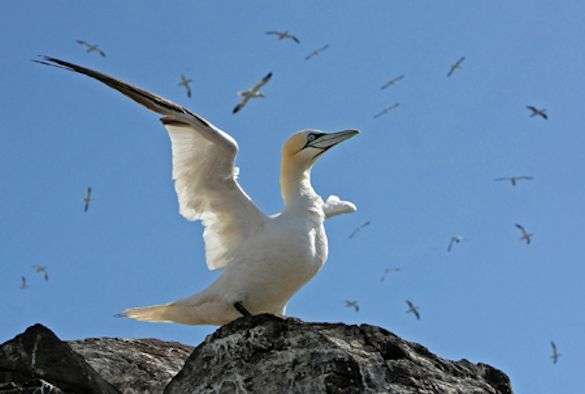Gannets to be tracked in real-time using 3G technology

The University is part of an innovative project that will track in real-time – using the 3G mobile network – the vast distances gannets fly.
This is the first time this type of monitoring has ever been attempted for birds at sea.
`Track a Gannet' – or T.A.G for short – gives people the chance to see how Britain's largest native seabirds journey through the English Channel from nests off Alderney in the Channel Islands to find food for their chicks, with data from GPS tags uploaded onto the web.
The data has already revealed a fishing trip totalling more than 800km (500 miles) through the Channel and one bird has been tracked flying up as far as the Thames Estuary
The website where the flight paths of the gannets are uploaded also has a live webcam streaming images of the gannets nesting on a exposed 25 metre high (82 ft) rock three miles offshore, where 2,200 pairs of the birds nest.
The project is jointly run by the University of Liverpool, Britain's smallest Wildlife Trust, the Alderney Wildlife Trust (AWT) and the British Trust for Ornithology (BTO).
Alderney's northern gannets are the most southerly breeding population of the birds in the British Isles, and the species is "amber listed" amid conservation concerns that it only breeds in significant numbers at a small number of locations.
Dr Jonathan A Green, Senior Lecturer in Marine Biology at the University of Liverpool, said: "Marine Renewable Energy Installations have the capacity to make a major contribution to meeting CO2 emissions targets, but the impacts of these installations to biodiversity are still very uncertain.
"Our work at Alderney is one of a very small number studies which is trying to make an assessment of how seabirds might be impacted, whether positively or negatively. We are very excited to be working in partnership with AWT, ACRE and the BTO. Using the very latest generation of tracking devices we can gain unparalleled insight into the behaviour and ecology of these fascinating seabirds."
TV presenter Simon King, the Alderney Wildlife Trusts' president, said: "In the last decade webcams and television have brought the drama of 'the bird nest' into millions of people's homes.
"At the same time GPS tagging has helped scientists to understand so much more about what birds get up to, from where they forage to how they travel thousands of miles on migration. What's being done in Alderney uniquely combines both technologies and more."
More information: The journeys being made by the gannets and the webcam of their nesting site can be seen at www.teachingthroughnature.co.uk/t-a-g
Provided by University of Liverpool



















